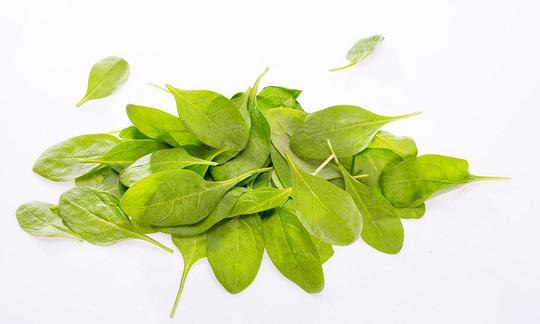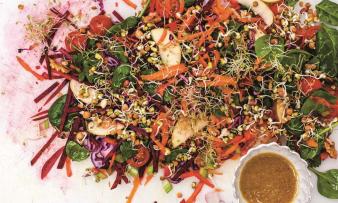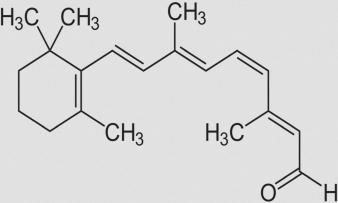Baby spinach is the extra early harvested spinach with very fine, tender leaves. Even those who don't like spinach will be tempted by this young leafy vegetable.
Use in the kitchen:
Baby spinach is rich in many vitamins and minerals. The early-picked leaves have only fine leaf panicles and a barely developed stem. The delicate leaves taste sweet when raw with a subtle bitter note. Baby spinach is a salad delicacy with unlimited variation possibilities.
Children often shun green leafy vegetables because of the bitter substances. Children perceive bitterness more intensely than adults. Bitter taste warns of something inedible or poisonous. Over the course of life, taste receptors change, ie they lose sensitivity. People also learn through experience.
Raw leaf strips can be used as an ingredient to refine pasta dishes or casseroles. A pesto made from baby spinach also goes wonderfully with pasta or in salads. Blanching reduces the nitrate content because the water-soluble nitrate remains in the cooking water. The slightly astringent taste is also reduced. Steamed or fried, baby spinach leaves can be used in soups, stews or quiches. 1
Baby spinach decreases significantly in volume when processed and some important ingredients are unfortunately lost. The tender vegetable requires careful preparation. Pick young spinach, wash it, do not squeeze or spin it and dry it with a cloth. 2
Low-calorie, delicious smoothies with baby spinach are ideal as a healthy snack. Never add more than 5 ingredients, otherwise the drink will be too heavy. If consumed regularly, sip by sip, the digestive organs will adjust to the mix.
| Not only vegans or vegetarians should read this: Vegans often eat unhealthily. Avoidable nutritional mistakes . |
Shopping:
Spinach is in season in western Europe between February and May. It is available in every supermarket. Greenhouse-grown spinach can also be found in domestic production (Germany, Austria, Switzerland) until November.
When buying loose spinach at the weekly market, you should pay particular attention to ensure that it does not have brown or limp leaves. Give preference to open-air cultivation and organic production. Out of season, you can use quick-frozen spinach, which does not lose its nutrients and vitamins.
Found in the wild:
Spinach grows wild in temperate and subtropical regions up to an altitude of 1550 meters. But spinach can also be found in central Europe and eastern North America. Green Henry ( Blitum bonus-henricus , syn.: Chenopodium bonus-henricus ) is still considered wild spinach today.
Like garden spinach, green henbane belongs to the Amaranth family. In the Balkans, crushed rhizomes are used to make confectionery that tastes similar to peanut butter. The flowers are steamed like broccoli. 7
Homemade preparation:
The nitrate contained in spinach, which is itself non-toxic, is converted by bacteria over time into nitrite, especially when cooked. This has an acute effect on the transport of oxygen in the body. You should therefore refrain from reheating spinach several times or keeping it warm for very long. In the presence of the corresponding amino acids and under the influence of heat, nitrite can turn into carcinogenic nitrosamines. 3
It is not advisable to eat spinach and fish products at the same time, as this would contain the necessary amino acids that are responsible for the formation of nitrosamines.
Storage:
Please store baby spinach in the refrigerator. As with all fresh foods, the vitamin content decreases quickly with fluctuating temperatures and exposure to light. Covering with a damp cloth will slow down the wilting process.
If you blanch the spinach leaves briefly, rinse them with ice water and then freeze them, the spinach will have a longer storage time (up to about 10 months).
Ingredients:
In addition to iron, spinach contains lutein (carotenoid) and beta-carotene (precursor of vitamin A). Both are important for the eyes 10 and the immune system. Minerals such as magnesium, phosphorus, potassium and the trace element selenium are also present. The vitamins protect the liver, prostate, gastrointestinal mucosa and support memory. Vitamin K 1 is important for blood clotting. Folic acid (folate) is involved in many metabolic processes in the body. Compared to other leafy vegetables, spinach is very rich in plant proteins. See also the entry Spinach, raw .
The myth of Popeye and spinach as a miraculous source of iron is not true. 4 Nevertheless, spinach is considered a healthy food (see the following two chapters).
Health aspects:
The oxalic acid contained in spinach binds the iron and prevents the body from absorbing it properly. When eaten with potatoes or peppers (vitamin C), the body absorbs the plant-based iron better. The antioxidants contained in spinach are said to have a cancer-preventing effect. Baby spinach leaves, i.e. very young spinach leaves, contain less oxalic acid than raw, fully grown spinach.
Fresh leaf spinach juice is extremely effective against anemia and is highly recommended for all athletes and young people in their growing years. Half a glass a day ensures optimal effect. 9
Dangers/Intolerances:
Some minerals such as calcium form complexes that are difficult to dissolve when they come into contact with oxalic acid, which makes it difficult for them to be absorbed through the intestines. Oxalic acid also attacks tooth enamel. In large quantities, the acid also contributes to the formation of kidney stones.
However, when eaten in reasonable amounts, the positive properties of spinach clearly outweigh the negative ones. According to Wikipedia, the lethal dose of orally ingested oxalate is 600 mg per kg of body weight, which corresponds to around 4.5 kg of raw spinach for a 60 kg person. The disadvantages soon outweigh the negative ones, probably starting at around 1 kg of spinach per person, but who eats that anyway?
In greenhouses, plants are often given nitrogen fertilizers, which means that spinach accumulates nitrate. This is converted into nitrite, which impairs the transport of oxygen in the body. This is particularly dangerous for children. If cooked spinach is reheated or kept heated, the nitrite present can form carcinogenic nitrosamines.
There are risks associated with feeding four-legged friends a vegetarian diet. Puppies and dogs with kidney problems should not be fed spinach at all because of the oxalic acid.
Use as a medicinal plant:
Spinach is considered a remedy for flatulence (carminative), the seeds act as a laxative. Hypoglycemic (blood sugar lowering) properties have been proven. The spinach leaves have a fever-reducing (antipyretic) and anti-inflammatory effect in inflammation of the lungs and intestines. The seeds were considered a remedy in the treatment of respiratory organ problems, liver inflammation and jaundice. 5 Spinach is also said to help against tiredness and loss of appetite.
Occurrence:
The origin of spinach is not clear. It is believed to have originated in Southwest Asia from the wild spinach species Spinacia tetrandra Stefen ex M.Bieb. and Spinacia turkestanica . A precursor to our modern spinach was cultivated in Persia as ispanāğ. The Arabs brought it to Spain as isbanāh, where it was first mentioned in the 9th century as espinaca.
Spinach only reached Central Europe in the 13th century. Today, spinach is cultivated as a vegetable plant in temperate zones around the world - in Europe, especially in Italy, France and Germany.
Cultivation, harvest:
Sowing is still possible in September, but the young plant must be protected from cold frost. The first harvest of tender baby spinach can be expected from the greenhouse in early spring. Spinach tastes best when young. When the flowers and seeds of the plant form, the leaves are no longer so tender.
Caterpillars, lice, bugs and leaf miners also like the plant. Mildew and molds such as Cladosporium attack the annual plant. When growing, make sure to plant widely and check regularly for pest infestation.
General information:
For botanical information, please refer to the entry Spinach, raw .
According to Wikipedia, the chlorophyll from spinach leaves is added as a green food substance in mouthwash and odor-binding products. The green color is also very suitable for coloring pasta or other foods. 7
The misconception that spinach contains excessive amounts of iron is based on two different assumptions. In 1890, the Swiss scientist Gustav von Bunge correctly calculated that 100 g of dried spinach contained 35 mg of iron. These figures were incorrectly applied to fresh spinach, which only contains about a tenth of the iron. 4 The second assumption is based on an accidentally misplaced decimal point, but this has never been proven. 6
Spinach stains are particularly stubborn. Ideally, you should tackle them immediately. Soapy water is usually sufficient. If immediate treatment is not possible, the following applies:
Home remedies for removing green spinach stains from carpets and clothing (such as trousers, jeans, sweaters, shirts and t-shirts) include raw potatoes, buttermilk and soap. Procedure: Rub the stain with a raw potato slice and then rinse with warm soapy water.
Spinach stains in combination with cream or fat can be pre-treated with a little mild detergent and washed or removed directly. To do this, moisten the stain with water, apply the detergent directly to the stain and leave to work for a while. Then remove the spinach stain with a damp cloth.
Buttermilk is known to absorb the dye from clothes. To do this, soak the item of clothing with the spinach stain in buttermilk. The next morning, you can wash the item of clothing as usual. Gall soap can also remove spinach stains: leave it to work for about 15 minutes and then wash as usual. 8
Literature / Sources:
bauerntuete.de/ babyspinach-use/
t-online.de/leben/ essen-und-trinken/ id_72683630/ babyspinach-tipps-zu-jungem-spinach.html
zeit.de/richtigs/ 1998/1998_6 _richtigs on Zeit.de
zeit.de/richtigs/ 1997/1997_41 _richtigs on Zeit.de
abcde Spinacia oleracea at Plants For A Future
Hamblin TJ. Spinach - I was right for the wrong reason. Mutated Unmutatex Blogspot. 2010;12.
Wikipedia: Spinach
flecken-entfernen.de/ spinach-stains-removal/
- Pamplona Roger JD Healing powers of food. Zurich: Advent-Verlag; 2006:36
- pro-retina.de/ research funding/ scientific advisory bodies/ recommendations/ lutein-and-zeaxanthin









Comments